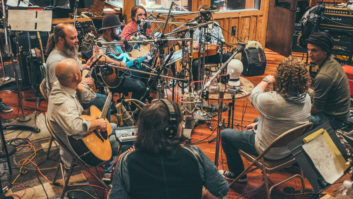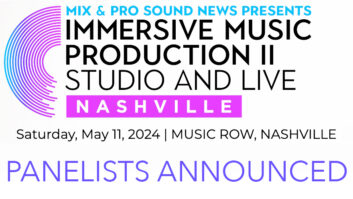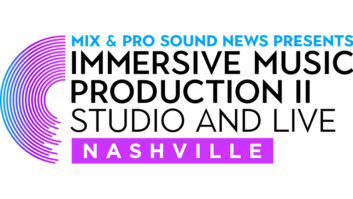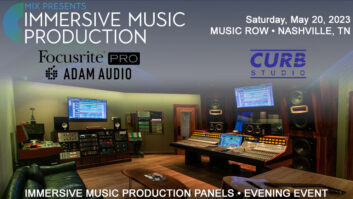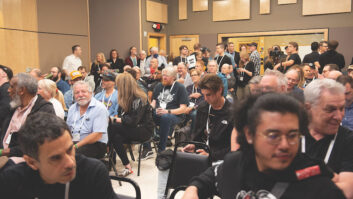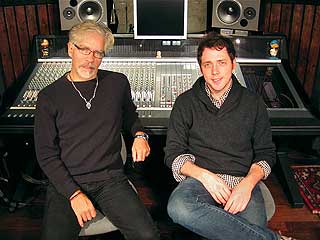
Robb Earls is 25 years into his Sound Vortex business: a quarter-century in Nashville, and nary a mainstream country record. Earls and house engineer/producer Derek Garten are fine with that. “Independent music has been a core of what we’ve done over the years,” Earls says, smiling.
Studio owner Robb Earls (left) and engineer/producer Derek Garten in Earls’ indie-centric Sound Vortex
The Vortex has been the spot for recordings by Lambchop, David Olney, Pat McLaughlin, Tom House and other folks who lean toward the idiosyncratic and tend to be labeled as mavericks or geniuses or anything but flavors of the month. Some studios are about commercial gloss and sheen. Sound Vortex has long been committed to making good music sound good.
The place started as a leaky basement back in 1985. Earls fixed the leaks, bought a D&R Dayner console built in Holland, updated that one and then replaced it with a 32-channel D&R Avalon. “I liked the D&R sound,” Earls says. “It doesn’t have the expense of a Neve or an SSL, and it’s a great, European-style console.”
Garten runs that console most days. He’s a Middle Tennessee State University graduate who worked as an assistant at Emerald Sound Studio (under Chuck Ainlay and others). “When Emerald closed down, I was faced with the decision of whether to become an assistant again or whether to produce and engineer,” he says. “I got the chance to come in here, carry on Robb’s legacy and establish myself as a producer, too.”
Garten began at Sound Vortex in the summer of 2008, and he quickly found that Earls’ cavern-like tracking space and modern control room worked well for the indie rock and pop music he favors. He’s been working with Daniel Cartier, Pico Vs. Island Trees and others, recording to Pro Tools HD and capturing huge-sounding drums that are typically set up on a riser built out of a waterbed frame.
“I love using the Sennheiser e 602 for kick drums,” Garten says. “I extend a Pearl Master custom drum off the front of the drummer’s kick and mike the Pearl, and it gives a whole subsonic low tone with a long decay instead of the kick drum just having a snap. I’m using it like a woofer.”
Two of Earls and Garten’s favorite Neumann microphones at Sound Vortex came from famed Nashville’s Quad Studios, where Neil Young, Linda Ronstadt, Dobie Gray, Jimmy Buffett, Dan Fogelberg and others recorded in the 1970s. Earls was able to purchase the mics from a lawyer who had kept them as part of his payment when Quad’s founders, David Briggs and Norbert Putnam, had to give the place up. “Look here,” Earls says, holding a Neumann U87. “DANOR is written on it, for David Briggs and Norbert Putnam. This could be the ‘Heart of Gold’ microphone.”
Another prize is the UREI 1176 compressor that Earls bought for $100, back in the days before Craigslist and eBay were there to enssure that $2,000 compressors didn’t go for $100.
“I’m a huge UREI fan,” Garten says. “I’ve also been really liking this DeMaria 1000 tube compressor, which is kind of like an LA-2A, but quicker on the attack, for snare drums.”
Musicians recording at Sound Vortex have access not only to the microphone supply, but also to a bevy of guitars, amps, drums and effects. Many of the instruments are tucked away (“Having less out, people can more easily envision their stuff in your space,” Earls says), but in a few moments Earls and Garten can produce a Fender Telecaster, a Gibson SG Special, an Ampeg Superjet amp or dozens of other tools of the trade. The vintage instrument arsenal helps lend a casual feel to the place. Sound Vortex has a band rehearsal space feel to go with its pro studio sound.
“From the beginning, I tried to create a relaxed, club-like atmosphere here,” Earls says. “We have ‘down’ lighting and a vibe that’s not overly polished. That’s the tracking room. But then in the control room, it’s almost the opposite: A high-tech-oriented environment where the logistics of everything have been thought out. We have a lounge like any big studio, but the heart of the thing is the tracking room and the control room.”
The tracking room is small enough for eye contact between musicians, but large enough to record a group like Lambchop, which often features eight or nine people playing at once in the studio. The walls are decidedly custom, thanks to a stone mason Earls hired long ago when he was transitioning the room from basement to studio.
“I had to leave one morning, and he asked me, ‘What kind of finish do you want?’” Earls says. “I said, ‘I don’t know, just make sure it’s not flat,’ because I didn’t want sound bouncing around. I came back later on, and he had taken a rubber boot and hit the walls with it. You can still see the boot marks in some places on the wall.”
